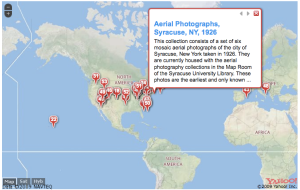I recently attended the Museums & the Web 2009 conference in Indianapolis, IN. Prof. Mike Twidale and I were there to do a live patchwork prototyping demo of the IMLS DCC Collection Dashboard concept. We had a great crowd of attendees in our booth who provided us with lots of great ideas for next steps (more on that, and a similar demo we did at HASTAC III later). But I also participated in several “unconference” conversations about the semantic web and open/linked data.
At the moment, information from the IMLS DCC is only available via the website and via our OAI-PMH data providers (one for collection-level records, and another for item-level records). While these are great for sharing records between repositories, they don’t necessarily make the information that we have accessible to cool web services like Yahoo! Pipes. Mia Ridge, at the Science Museum in London (and keeper of the Museum API wiki) issued a challenge for us to DO ONE THING before April was over. So here’s my attempt at DOING ONE THING with IMLS DCC. (and is admittedly just a baby step).
One of the services I learned about at MW2009 is Dapper, a tool that will screenscrape HTML pages to produce various kinds of output that you can share with APIs (application program interfaces). Dapper fits nicely within our Patchwork Prototyping toolbox, as it lets us play with some IMLS DCC data in ways that we couldn’t before and without having to actually build an IMLS DCC API first. One of the desirables that came up in both our MW2009 and HASTAC demonstrations was being able to see IMLS DCC collections on a map. So here we go…
First I screenscraped the list of IMLS DCC Collections By Title page. Dapper then allowed me to create:
I took the Atom feed and passed it to the location extractor in Yahoo! Pipes to generate a map.
This is just a first baby step towards building other widgets for a collections dashboard! It needs some work (only a certain number of collections will appear on the map at any one time – you need to browse through the list to see more collections), but the idea behind the DO ONE THING challenge was to take some simple steps to build momentum.
A special thanks to colleague Piotr Adamczyck and his MuseumPipes blog for inspiration!
Filed under: Interface | Tagged: collections dashboard, Dapper, mw2009, Yahoo! Pipes | 2 Comments »



You must be logged in to post a comment.